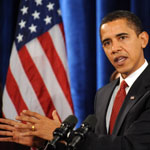
The U.S. government is prepared to lend more than $7.4 trillion on behalf of American taxpayers, or half the value of everything produced in the nation last year, to rescue the financial system since the credit markets seized up 15 months ago. The unprecedented pledge of funds includes $2.8 trillion already tapped by financial institutions in the biggest response to an economic emergency since the New Deal of the 1930s, according to data compiled by Bloomberg. The commitment dwarfs the only plan approved by lawmakers, the Treasury Department's $700 billion Troubled Asset Relief Program. Federal Reserve lending last week was 1,900 times the weekly average for the three years before the crisis. When Congress approved the TARP on Oct. 3, Fed Chairman Ben S. Bernanke and Treasury Secretary Henry Paulson acknowledged the need for transparency and oversight. Now, as regulators commit far more money while refusing to disclose loan recipients or reveal the collateral they are taking in return, some Congress members are calling for the Fed to be reined in. – Bloomberg
Dominant Social Theme: The Fed is on the job (and how!).
Free-Market Analysis: Gee, we figured that central banks around the world would spend up to $100 trillion on the financial crisis, and the United States is already closing in on US$10 trillion. Things are moving fast! Of course, US$100 trillion sounded like an absurd amount, but watching the way the Fed was throwing money around, we concluded (and you read it here first) that US$100 trillion, worldwide, was a good safe bet. Of course perhaps central banks won't get there, but if you add up all the corollary spending that will take place to stimulate jobs, etc., you'll probably end up around the number. And if you throw in stock and bond losses (evaporating capital) from the financial crisis, you'll probably get there a lot sooner.
The terrible thing about all this money (and US$100 trillion is ten times the US national debt) is that it is available at all. For years (certainly in our lifetime) we have listened to innumerable lectures about US savings rates, and endless arguments about welfare, about government "pork" and of course about the necessity to raise taxes. But now it turns out all of this is "chump change." In fact (as we sorta knew all along) the US didn't really the need the tax revenue it requires from its citizens, not when it can raise US$7.2 trillion in a couple of months. And what about the government pork that John McCain is so exercised about – that's nothing compared to US$100 trillion.
But heck, let's stick with the US$10 trillion figure. That's still just about the ENTIRE SIZE of the US national debt. Yes, that terrible debt figure that somebody paid to have hanging up in Times Square as a digital reminder that America's kids were endlessly in hock. This kind of money makes a mockery of hard-working Americans who scrimp and save and invest and hope to earn enough money to assure retirement. It makes a mockery, even, of the profits of multinational corporations who number their profits in hundreds of millions – or even a billion – but US$10 TRILLION? Bill Gates is worth about US$50 billion and he is or was the richest man in the world. But US$50 billion is a tiny fraction of US$10 trillion, let alone US$100 trillion.
This financial crisis is obviously panicking the monetary elite.This is simply too much money to show the public. It's just too much. It illustrates that the current financial system has little to do with normal profit and loss. In a believable financial structure, everyone plays by the same rules. But there are no rules here, simply powerful folks close to a money spigot that they can seemingly turn on and off at will.
The sums that are being tossed around are hard even to comprehend. How can representatives of the Federal government ever turn around and look the electorate straight in the eye and talk about fiscal responsibility after these kinds of numbers? How is Congress going to argue over the nickels and dimes of a tax cut credibly, when the nation they run can reach into its collective back pocket and pull out a quick US$10 trillion.

What's going on is a collapse of the fiat money system, something that the monetary elite will seemingly do anything to avoid – even to the point of revealing just how absurd the system really is. In truth it is a pretend system, and these kinds of numbers point that out. It is a system that mimics an honest money system, but in a normal financial structure, even the most powerful man or woman in the world must accumulate money one gold coin at a time. In a fiat money system you can print as much as you want – and folks who didn't understand what that really entails must surely be starting to get the picture about now. And once they "get the picture" here is the next question to ask: What will all this money do to the dollar over time? We would propose a free-market definition of inflation: more money than the economy can absorb. And folks, this is likely much more money than the economy can absorb. We are figuring on a roaring inflation sooner or later – but if the spending keeps up at this rate, we may see something approaching a hyperinflation. Got gold?
